
NEWS ALERT July - Dec.2015
Dec. 20, 2015
Whitey's Christmas Story
He'd been around at least 4 years - always keeping his distance. They'd never been able to get him neutered & vaccinated. When they offered food, he'd accept it but he'd always shy away from using shelters.
The winter had been a harsh one; he hadn't shown up for such a long time that they feared he hadn't survived. Then, one spring day, there he was - on the doorstep looking for a meal.
He was 7 or 8 - maybe older; it was becoming obvious that the years of living homeless were taking their toll. Every year they had noticed how much more tattered and torn his ears were becoming (from frostbite and fights) and that day he was looking particularly thin and frail. He still wouldn't let them get close to him but they managed to get some deworming meds into him and he'd started putting on some weight.
By the end of summer he'd become something of a regular and there were signs that he was beginning to trust them. One snowy night early in December (2014), he let them pick him up and put him in their garage overnight. But shortly after that he disappeared again. The weather turned bitter cold.
On Christmas Eve they found him collapsed on their doorstep - his eyes infected, his fur matted with tar, his jaw puffy "like mumps," an oozing sore and scabs on his neck, a leg swollen and unable to put any weight on his paw. He let them pick him up and carry him to the garage. They cleaned him up and made him comfortable; he settled in for the night and, on Christmas Day, was sleeping, eating, using his litter box and allowing them to cuddle him.
It was on the 27th that we (Rescue Hamilton Cats) received an email entitled: "Helping a local stray with vet care and neutering." It chronicled his history and his condition and explained how, while they weren't in a position to cover all the vet costs, they'd contribute what they could, care for him during his recovery and, if he had no infectious diseases, try to make him part of the family. They explained how integrating him into their household could be really difficult because the resident cats (all rescues themselves) would have trouble accepting him but they'd promised to work at it.
They'd nicknamed him "Whitey" and found out that two neighbours who had also been feeding him also were calling him "Mr. Whitey;" so, the name stuck. On the 28th they sent this photo of him.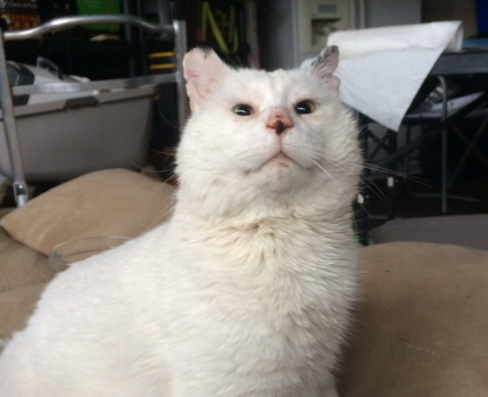
Whitey was clearly in rough shape and in urgent need of vet care; his future was looking bleak but maybe, just maybe, he had a chance. It's giving cats like Whitey a chance that rescue is all about but, in this case, it was feeling like we needed a miracle.
At that point, a volunteer, who works with one of the local groups providing some support and access to services for caregivers of Hamilton's many street/community cats, got involved. She called a veterinarian who is very familiar with the plight of desperate cats like Whitey and, in the spirt of the season, she agreed to see him.
On December 31, 2014, Whitey was transported to her and examined, neutered, vaccinated, dewormed, given a flea treatment, provided with the meds he needed and tested for infectious diseases. The blood work looked surprisingly OK and there was a sigh of relief when he tested negative for FIV/FeLuc.
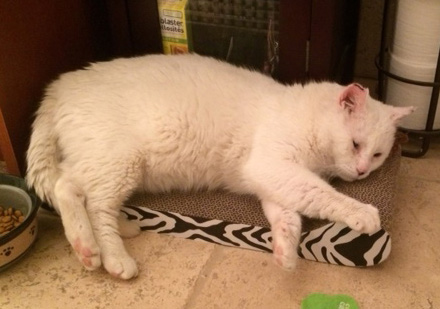
Whitey got to spend New Year's Eve back "home" and remained for the first few weeks in the bathroom but, as this photo, taken in early January, shows, he was starting to recover - and to relax and to appreciate the comforts of indoor life.
Then, gradually, he was introduced to the other cats. As expected, it didn't go smoothly but, as the weeks and months went by, he got to spend more and more time out of the bathroom. Now he shares the upstairs with the females, coming downstairs to spend time with the males only when they can supervise. The guys haven’t totally accepted him but they're working it out.
Occasionally, he suns himself on their deck and plays in the fenced-in yard and he has no interest in his former street life. Most days now he lays in front of the fireplace enjoying the warmth and recently he’s assumed the role of family ambassador, welcoming two new rescues with nose sniffing and head licks.
This year, he’ll be home with his family for Christmas dinner and on New Year's Eve Whitey will be celebrating a whole year of living the life he'd never dared to dream of - and gratefully looking forward to 2016.
This recent photo of him sums up pretty well this happy ending story - a story that demonstrates what kindness can do.
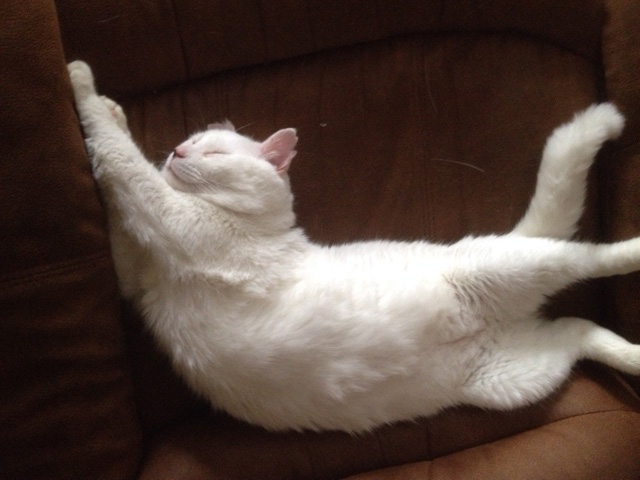
Printable version
---
November 14, 2014
Saving the seriously injured cats relies on private funding
Like any organization funded by public money, Hamilton Animal Services (HAS) operates within limits; decisions made about what's best (most humane) to do have to be made according to budgets and according to rules about how taxpayer money is to be spent.
Every day cats arrive at HAS - last week (Nov. 3-9) there were 56 who came through those doors. Some are lost, some are strays; some are healthy, some are sick - and always there are a few in pretty bad shape.
Among last week’s arrivals was one who'd been picked up with an open, festering wound full of maggots. She'd been taken directly from where she was found to a vet who'd flushed out the wound and prescribed medication. But soon staff were noticing that the wound was infected again and that she wasn't doing well.
Another seriously injured one was a little tabby who'd been brought in with severe burns on his neck and face; he too was obviously suffering.
The most frequent reason given for making the decision to euthanize is "health" and sometimes that means, as it would have in these cases, that without extensive medical treatment, there was nothing in the future other than a prolonged, painful death. That weeks HAS stats listed “health” as the reason to euthanize in 10 (of the 11) cases. And it would have been higher by 2 (these 2) but for the privately funded organizations that stepped in.
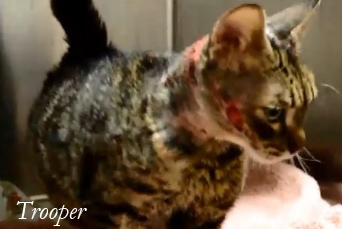 The sweet little burn victim got transferred over to the HBSPCA. A posting on that organization's Facebook today (Nov. 14) announcing that he's now goes by the name Trooper, reports that his burns are healing nicely and provides a video showing how well he's doing. The sweet little burn victim got transferred over to the HBSPCA. A posting on that organization's Facebook today (Nov. 14) announcing that he's now goes by the name Trooper, reports that his burns are healing nicely and provides a video showing how well he's doing.
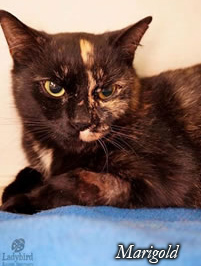 The lovely tortoiseshell with that awful wound, now named Marigold, got rescued by Ladybird Animal Sanctuary and updates on their Facebook report that, despite a lot of damage to the surrounding skin and muscle, her wound is healing well. X-rays taken showed that her hip was fractured and further x-rays will determine if the hip fracture will require surgery. But she's eating and using her litter box and she's likely to pull through. The lovely tortoiseshell with that awful wound, now named Marigold, got rescued by Ladybird Animal Sanctuary and updates on their Facebook report that, despite a lot of damage to the surrounding skin and muscle, her wound is healing well. X-rays taken showed that her hip was fractured and further x-rays will determine if the hip fracture will require surgery. But she's eating and using her litter box and she's likely to pull through.
These two lucky cats will be forever indebted to the organizations that took them into their care.
And something every cat lover in this city needs to realize is that the HBSPCA, Ladybird, and all the other groups that take these high cost cats, and so many, many others too (the total so far this year is 1,790) into their care, face paying some pretty hefty bills - likely far exceeding what many (likely most) loving pet owners could afford to pay.
All of these groups are privately funded and, while it's true that unlike HAS they are free to decide how to spend their money and do commit themselves to spend whatever it takes to save these cats, they too don't have access to unlimited funds. They can't afford to say 'yes' to taking every desperate case that lands inside HAS. And the ones they do take into their care, ones as expensive as these two, can drain the bank.
The reality is that HAS, being publicly funded, is an organization that does what it can for these cats within the limits imposed. The other reality is that these privately funded groups rely on donations from the public. When they take cats like Trooper and Marigold into their care, they want cat lovers to follow the stories and think about donating. For anyone wondering where money donated to animal rescue organizations goes, tuning in to their Facebook pages is a good way to find out.
---
Oct 17, 2014
Some cats rescued but others at HAS remain anxious
He'd waited 3 fretful months at HAS knowing that, being black, 7 years old and needing dental work, his chances of getting out weren't good. But he just kept purring and hoping. And, on Thanksgiving weekend, a sponsor pledged a 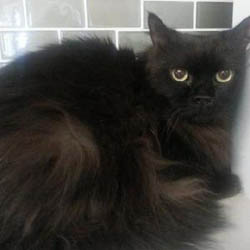 donation towards his vet bills, a volunteer driver picked him up and he was transported (in a carrying case borrowed from HAS) to one of the rescues. Finally able to relax, he's purring and hoping again - this time for his very own forever home. donation towards his vet bills, a volunteer driver picked him up and he was transported (in a carrying case borrowed from HAS) to one of the rescues. Finally able to relax, he's purring and hoping again - this time for his very own forever home.
We're proud to have this fellow (Houston) posted now as the Featured Cat on our Adoption Page.
We're happy to report the additional good news that the only other remaining three cats who'd entered HAS as long ago as Houston did - back in July, have been rescued too.
As we celebrate this good news and cheer these lucky cats on, there's another reality that we mustn't lose sight of.
The stats from last week show that, while 36 cats were exiting happily to return to their owners or to go to rescues, 61 others were entering through the doors of HAS. If you do the math, the message is that:
Overcrowding is still a big problem!
What does this mean to the cats in cages at HAS today - the 25 cats who arrived back in August, the ones who joined them in September, and those who have arrived thus far in October? Well - they're in danger of being euthanized for "space" and waiting anxiously now to be rescued too.
---
Sept 30, 2014
Time up for a long-term resident?
She arrived on July 4; she's prettier than her photo and staff at HAS say that, while a bit shy and nervous, she's friendly when someone pets her. Their description of her ends with the comment: "she just needs time".
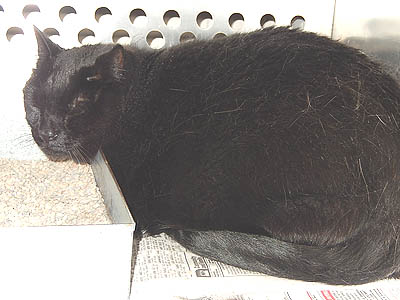 But time may be running out. HAS is horribly overcrowded. One of those urgent messages was sent out yesterday to rescues and once again there's a "closed" sign on the door. The rescue groups, themselves full and strapped for funds, are rushing in - but can they empty enough cages and can they do it fast enough? Though HAS is turning away the non-emergency cases, they're still responding to emergency calls and they're still taking in the sick and injured ones that keep arriving at the door. But time may be running out. HAS is horribly overcrowded. One of those urgent messages was sent out yesterday to rescues and once again there's a "closed" sign on the door. The rescue groups, themselves full and strapped for funds, are rushing in - but can they empty enough cages and can they do it fast enough? Though HAS is turning away the non-emergency cases, they're still responding to emergency calls and they're still taking in the sick and injured ones that keep arriving at the door.
So things are pretty tense for this black girl right now. If it comes to the point when there are simply more cats inside than HAS can possibly house and care for, some will have to be sent out to be euthanized. As the longest term resident there, she's in danger of being among them. It will be a matter of who gets chosen. It may be her – or another long term resident – or maybe one of the sick or injured ones whose time is up.
Other than scream or cry or turn away and avoid looking at her photo (or the photos of the other 14 who have been there nearly as long), what can Hamiltonians do? Well, in the long term, there may be a long list of things to consider but one thought that comes to mind today is offering to foster or to make a donation that helps cover the costs of rescuing this one - or another of the long term residents.
---
Sept 5, 2014
Closed doors at HAS: What does it mean?
Several times this summer HAS has closed its doors.
Usually it's been for a day or so – just as long as required to get enough cats out so that none had to be euthanized/killed for "lack of space."
On one occasion (in mid-August), the doors remained closed for an entire week. People arriving during business hours carrying caged cats and kittens were told that, due to overcrowding, HAS wasn't able to accept them. They were understandably frustrated. Some became angry; one reacted by emptying a cage of kittens outside the building, leaving HAS staff with no option other than to chase and capture them and bring them inside.
The reasons HAS had not wanted to take them, and all the others arriving, inside were:
(1) They were already so overcrowded that even mothers and kittens were in danger of being euthanized. An alert had gone out to rescues and by the time HAS reopened, enough cages had been emptied that none of these little families (and, in fact, no cat) had to be killed for "space." (The cats featured on our adoption page for the month of September is one of these families whose lives were saved.)
2) There was a suspected case of ringworm and a genuine fear that this or another highly contagious illness, could spread through the shelter because the isolation room was no longer available. This suspected case was a mother and her kittens and this little family also was rescued by another group - one that had a way to isolate ringworm cases. By the time the shelter reopened its doors, the threat had past and the isolation room was cleaned and available again for use.
Anyone who recalls the pre-2011 era when overcrowding was so extreme that week after week adoptable cats (and kittens) were being euthanized for space and has in their heads the horrific images of times when outbreaks of disease resulted in "mass executions" of entire shelter populations will understand these reasons.
Yes, the current reality is vastly different. "Space" is now rarely identified as the reason to euthanize and a year-to-date 2014 euthanasia rate of 18% stands in encouraging contrast to the 50% rate in 2010. But overcrowding remains a serious problem throughout kitten season - which has just recently spiked and won't be subsiding for some time.
Instead of seeing HAS as the problem, it's time to start viewing what happens there as a reflection of a larger problem; one that every pet owner and cat lover in the city can help to solve. A Hamilton Spectator article dated August 26 gets across the seriousness of the situation and points out some things Hamiltonian can be doing to become part of the solution.
---
August 22, 2014
Spay/Neuter and Adoption Proposal
to go to city council
HAS has long been criticised for not addressing the urgent need for low-cost spay neuter and not running an adoption centre. An overhaul of the service planned for early next year, if approved by city council, would address both issues.
According to the CBC (22/08/14):
City council will vote this fall on whether to fix its “prehistoric” way of dealing with animals by…
Read more…
-----
August 1, 2014
What we need to know about
"The killing of cats at HAS"
A recent CBC news item, Hamilton animal services wants to kill fewer cats, ( July 17, 2014 ) served as a reminder that emotions still run high around HAS and "the killing of cats." Uninformed opinion continues to shape the public perception of what's going on at HAS.
It's hard to believe that such inflammatory labels as "extermination facility" are still appearing in the media and that statements are highlighted that fit that image.
Far more attention needs to be paid to the facts and to the details - to the continuing decline in the number of cats being euthanized there (250 to date (July 27th) this year) and the factors contributing to that decline.
The reality is that every city is faced with a cat overpopulation problem and that shelters across Canada (including Calgary) are making tough decisions.
Karen Edwards, Animal Services Advisor at HAS earlier this week provided a summary of how HAS staff are making them:
“I have been hearing that people still feel our euthanasia numbers are high. I think that the public is not aware of some of the factors involved and the hard decisions made with the euthanasia of animals here...Read more
-----
July 15, 2014
Communication Works
Last Tuesday, when they found themselves full and many adoptable cats and kittens were in danger of being euthanized because they needed more space, HAS closed the shelter from accepting any more cats. They got to work  quickly, alerting the HBSPCA and all the local and out-of-town rescues they work with and something amazing happened. As if by magic, 46 rescues took place. HAS was able to open up the shelter again and, as the stats for the week show, managed to end the week not having had to put down any one of those cats or kittens due to "Time/Space." quickly, alerting the HBSPCA and all the local and out-of-town rescues they work with and something amazing happened. As if by magic, 46 rescues took place. HAS was able to open up the shelter again and, as the stats for the week show, managed to end the week not having had to put down any one of those cats or kittens due to "Time/Space."
This is the season when the danger of filling up beyond capacity is ever-present. And when saving lives very often relies on fast action and heroic gestures.
HAS may not have their own adoption service but they do have a system for getting cats transferred to organizations that run effective adoption services. What happened last week might be viewed as "magic" or it might be seen as a demonstration that this system can be made to work.
It's a system that relies on swift, clear communication between HAS and all the organizations that give the adoptable cats in their shelter the chance to be adopted into forever homes.
Rescued (and adopted) last week >>>
-------------------
May 29, 2014
Stats are back AGAIN
After a false start in April when numbers didn't add up, HAS stopped sending us stats while they 'worked' on the problem.
Almost two months later, we got the Year-To-Date numbers and then the first weekly stats for May 19-25. We don't have the earlier 'weeklys' so we have to assume that the adding errors were corrected.
If the numbers are accurate then INTAKE so far this year is 2/3rds that of 2013, most likely due to a change of policy that virtually stopped pickup of strays.
We'll keep watching and reporting on trends over the coming months.
-------------------
April 1, 2014
Stats are back
Don't Be Fooled!
This announcement is NOT an April Fool's joke.
As of yesterday, we've started receiving the stats again from HAS. A change of the software program in January was followed by a glitch and delay and more glitches and delays, and now, finally after two months, the stats that keep us current about what's happening to the cats at HAS are being made available.
Our ticker tape is up & running again; so, scroll to the bottom of our Home Page and take a look at the stats from last week as well as the up-to-date stats for the first three months of 2014 (YTD)
So far this year, 16 cats have been returned home to their owners and another 428 lucky ones have made it out alive thanks to the efforts of the HBSPCA (which rescued 161) and other local & out-of-town organizations that have managed to rescue 256.
We are told that weekly statistics will be provided to us again every Monday; so, we'll be updating our tickertape next week and every week through to the end of 2014. Keep checking to stay current on what's happening to cats at HAS & watching for trends - AND hoping that these trends suggest that things really are changing for the better.
To get a sense of how the numbers compare to last years, check out Info Section for a summary of the 2013 information.
-------------------
March 12, 2014
Our Featured Cats from last month, Pepper & Petunia, have been adopted! 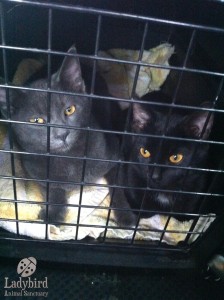
Congratulation to Ladybird, the group that rescued this special pair from HAS, and to the family that adopted them. This success story, posted on Ladybird's site is well worth reading. The pictures including the lovely ones of Pepper & Petunia in their forever home tell it all oh so well: http://www.ladybirdanimalsanctuary.com/site/pepper-and-petunia/
It's happy endings like this one that we wish for every Hamilton cat including, of course, the new Featured Cat on our site. Cookie was rescued about the same time as Pepper & Petunia, by Abandoned Cats, another local rescue that, like Ladybird, is putting a huge effort into saving the lives of unfortunate cats who, through no fault of their own, end up at HAS. We have our fingers crossed now for Cookie - a black beauty who will make some lucky person the purrfect pet.
-------------------
January 29, 2014
Lost Among the Strays: How Many Make It Back Home?
Losing a cat and never finding out what happened is a cat lover's nightmare. And just imagine how awful it is for the pet that gets lost and ends up at HAS (as a cadaver picked up on the road or as a "stray" desperately hoping to get rescued.)
Sadly, that seems to be what's happening for far too many owned cats in our City.
Over the years, the return-to-owner rate at HAS has remained dismally low and it's not getting better. Of the 3,908 cats taken in by HAS in 2012, only 151 (or 3.9%) were reclaimed by owners and, of the 3,384 cats that arrived in 2013, only 119 (or 3.4%) made it back home. There is no way to tell how many of those that were never reclaimed actually had homes but it is reasonable to assume that the number is large and that far too few are getting back to their homes.
When cats are wearing collars (with a registration tag or phone #) or have a microchip, HAS tries to contact the owners. But it's not a requirement in Hamilton that owned cats have ID of any kind. So, owners generally don't bother and most owned cats have neither collars nor microchips. Because these play such a key role in getting lost cats back home, HAS encourages owners to provide their cats with both a visible ID (that serves to get them returned quickly) AND a microchip (in case the collar becomes lost). HAS counts on owners to do that AND it relies on them also to make sure that the contact info is kept current.
When there is no way to contact the owner, HAS posts a photo of the cat on a Lost & Found website and, then, relies on the owner to be actively searching. Because many of us don't know how best to go about that and aren't making effective use of the free lost & found services available to us, RHC has just posted a new link on our Home Page
If we Hamiltonians can get more of our lost cats home or, even better, do more to prevent our cats from getting lost in the first place - by keeping our pets indoors & ensuring they have up-to-date ID just in case - many more Hamilton cats will be living out their entire 9 lives safe & warm & happy - at home with us. And fewer of us will be living that "lost cat nightmare."
-------------------
December 29, 2013
Happy New Year, Dear Cosette!
This blue cream tortie arrived at HAS as "just another stray." It's shocking how many of these stunningly beautiful cats end up there and sad that so many, confined as they are in small cages, succumb over time to sickness or become so despondent that they end up being euthanized just because they've given up hope.
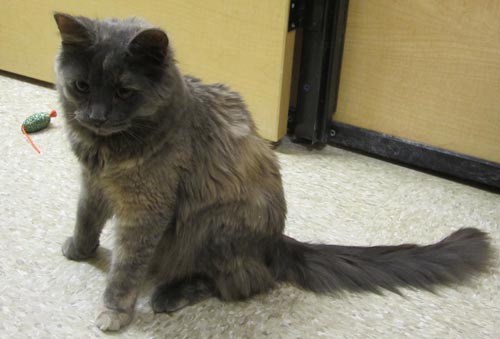
But this little girl had a glow about her and, even after 2 long months of waiting to be rescued, she remained sweet natured and retained an optimistic twinkle. She was a shelter favourite.
As time passed and Christmas approached, the staff, who had come to know and love her, were becoming more and more desperate to get her out.
The "festive season" is a tough time at HAS because, amidst all the holiday cheer it's especially difficult to come face-to-face with the reality that some of the cats there (sometimes even healthy ones) will get euthanized simply due to overcrowding - and, it was awful to think that, as a long-time resident, even she was at risk.
The staff kept hoping a rescue group would take her to safety but, for whatever reason, she just kept getting overlooked. Till, one day just before Christmas, one of the HAS staff told a Forever Home Cat Rescue (FHCR) volunteer, who had come in to rescue some kittens, about her and asked her to please take just a minute to meet her. And this little cat, getting this chance to demonstrate how adoptable she was, "sold herself" to the volunteer and got rescued.
This was a heartwarming moment at HAS and for this little cat, who quickly acquired the name Cosette (after the beloved character in Les Miserables), it was like a Christmas miracle. She got to spend Christmas, not lonely in a cage at an overcrowded shelter, but instead safe and warm in a loving foster home. 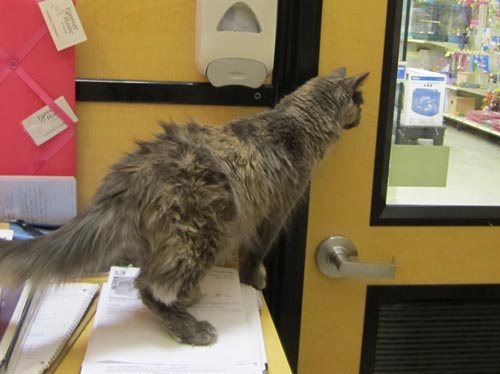
And, right after Christmas, having been checked by a vet (who declared her very healthy), vaccinated and spayed, Cosette got back into her carrying case and went with her foster mom to the adoption centre at the PetSmart store in Stoney Creek where a second miracle happened.
Cosette, curious to explore her new surroundings and not even yet settled into a cage in the adoption centre, got instantly adopted!
She'll be celebrating New Year's Eve with her parents in her purrfect forever home. Undoubtedly, all her friends at HAS and at FHCR will want to shout out:
Happy New Year, Cosette!
-------------------
November 20, 2013
Happy Endings
In late October RHC was contacted about 3 kittens, the offspring of a feral mother living on the McMaster campus in Hamilton. Two undergrads had succeeded in rescuing the lucky trio and were caring for them in their room. The kittens were thriving - feeling warm, safe and loved; they were settling in fine but clearly they couldn't stay. The problem was how to find them permanent homes. 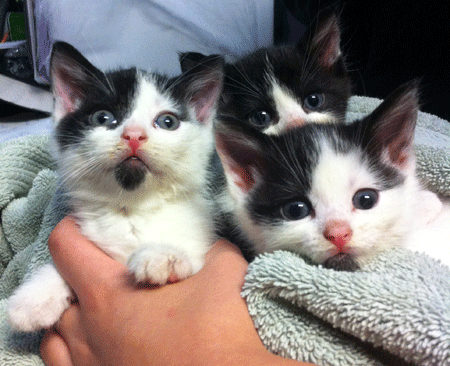
No rescue group had responded to the girls’ emails and, when the girls realized that they weren't hearing back because all the rescues were full to capacity, struggling with bills, and swamped with pleas for help, they thought about what they could do. They understood. And they knew that HAS was also overcrowded and that, if they dropped these adorable kittens there, they might well succumb to illness or be euthanized due only to lack of space. They just couldn't take that chance. They wanted to guarantee the kittens they had rescued would get adopted.
So, they called around and found a vet who offered to give them a reduced fee for the first shots. Yes - there really are some compassionate veterinarians in Hamilton who, when asked, offer to help.
Then the girls took a great picture, showed it around, and talked to friends, relatives and anyone they met; they got the word out about the plight of these kittens.
And doors opened! One of the kittens moved in with a neighbour, another with a relative and the third with a lady who was referred to them.
It's a heartwarming story and one in which we, at RHC, are excited to have played a small part. And it’s not the only "Happy Ending" story we’ve heard about recently. Here are summaries of a couple of the others:
- a kind lady in the east end who, already caring for several cats of her own, took in a desperate mom and her two lovely kittens and ended up keeping the mom, getting her spayed, and searching out homes for her lovely orange babies.
- a couple who found a cat with a punctured eye, took her to a vet to have her checked for a microchip, discovered she was pregnant, took her home so she could have her kittens in their shed, and worked out a reduced fee for necessary shots with the vet who then helped find homes for the kittens.
These stories show us that Rescuing Hamilton Cats isn't just about what HAS and the rescue groups can do, but also about what happens when people in the City take the initiative to do whatever is in their power to create "happy endings" for lost, homeless and abandoned cats who cross their paths.
-------------------
November 4, 2013
Tickertape of Stats
Something few people know is that HAS tracks, and reports weekly on, the # of cats it takes in and what happens to them. These numbers don’t tell the whole story but the current ones do give some sense of what is actually happening. Reliance on out-of-date ones is sure to distort the picture. So, as a new feature of this web site, we’ve added a tickertape at the bottom of our HOME page and we’re updating that every week so as to provide the most current Year-to-Date figures on Intake, Return to Owner, Transferred out to Rescues, and Euthanized.
Now, just two months from the end of the year, these weekly numbers are worth keeping an eye on. What they appear to be revealing are some interesting (and even hopeful) trends. It they continue, a comparison of the 2013 #s with those of 2012, may confirm that Intake is continuing to go down, the # of cats being rescued is actually (for the first time) rising, and the # ending up being euthanized is dramatically down. And that would indeed be a bit of good news.
-------------------
October 11, 2013
Kitten Season / Mother Season
"Kitten Season" is the term used to refer to the time of year when cats give birth, flooding animal shelters with litters of kittens.
Extending from early Spring into late Fall, it’s a difficult time at Hamilton Animal Services (HAS) – too often the shelter becomes overcrowded beyond capacity and, due to sickness, stressful conditions, and sheer lack of space, cats - including orphaned kittens, mothers with their babies and pregnant mothers - get scheduled to be euthanized.
As the minutes tick down, HAS staff send out urgent pleas to the rescue groups. These pleas are heart wrenching. Rescue groups rush in, taking out as many as they can, feeling terrible about the ones they have to leave behind and worrying about how they’ll manage to care for, and find homes for, the ones they rescue.
Over the months, as Vet costs to treat the sick and injured ones pile up on top of the bills for routine shots, spay/neuters and day-to-day food and litter, money drains away. And, when adoptions are slow (as they tend to be in the summer), and the feline families keep arriving, there’s a really sad point when they can take no more.
We're well into October now and, while Kitten Season may be slowing down, it’s clearly not over. At HAS, kittens, mothers and pregnant cats continue to arrive - overcrowding remains an issue and urgent pleas to save lives continue to be sent out.
And, at this time of year, while rescue groups have gotten homes for many of the kittens they’ve saved, they’re racing (against the clock) to get homes for those kittens still in their care before these kittens grow up and lose that kittenhood appeal that serves to draw adopters to them.
But what to do about all the mothers left behind?
This is the time of year that could be referred to as “Mother Season,” the time when so many 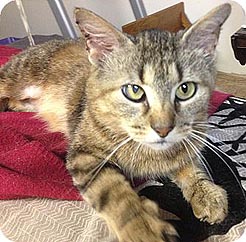 mother cats, having seen their litters go and having been spayed to avoid further litters, need to get adopted too and when the Rescue Groups are urgently needing help to find them homes. mother cats, having seen their litters go and having been spayed to avoid further litters, need to get adopted too and when the Rescue Groups are urgently needing help to find them homes.
So we’ve posted, as the Featured Cat on our Adoption Page, one of these lovely mothers. Having raised her 5 kittens and seen them find their forever homes, Willow is left, as so many mother cats are, wondering if her turn will ever come. She’s the face for all the mothers still waiting – our Poster Cat for Mother Season 2013.
-------------------
July 21, 2013
77 and counting
By Sunday July 14th, 77 cats had been euthanized at HAS for no reason other than “space” – a recurring problem since April. Too often in the summertime there are just too many cats there and when there's no room left at the shelter for new arrivals, it's the long term residents who may have to go.
Meet Taz, the Tortie. She was destined to be #78. The info card on her cage had been marked X/TS to show that on the next “vet day,” she was to be euthanized due to time and space. There was nothing wrong with her. She'd just been there a long time (waiting to be rescued), the shelter was full and her luck appeared to have run out.
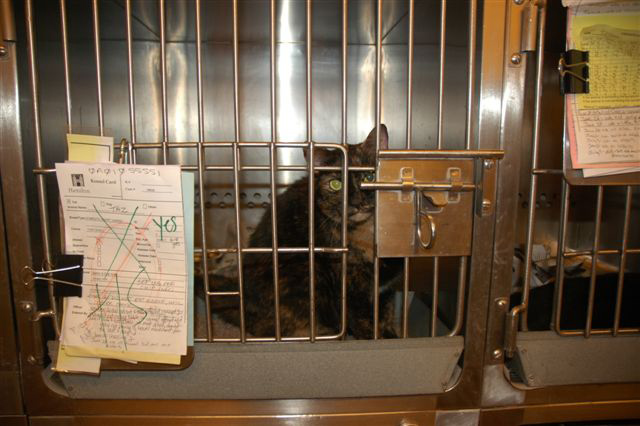
But a volunteer with an out-of-town rescue group who had came in to take some other cats, saw Taz's lovely face and she just couldn't leave her behind. So, she left with one more cat than she'd intended to take.
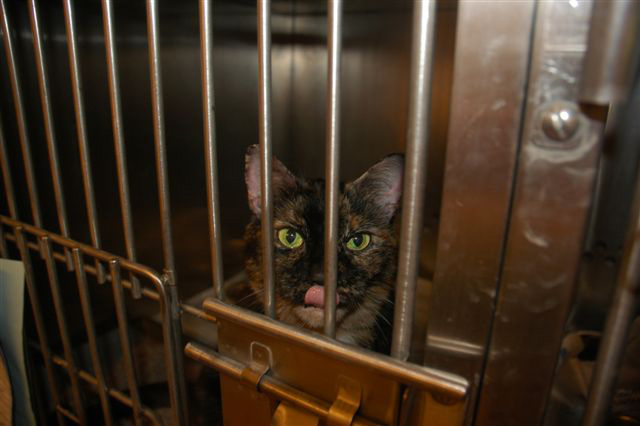
When the next "Vet Day" (the term used to refer to days when the vet is scheduled to euthanize animals) came around,Taz was already on her way to a better life. And the rescue groups had managed to get enough out that no cat had to be euthanized that Vet Day simply due to lack of space.
It's great to know that Taz is safe, relaxed and waiting now to get adopted. But it's still summertime; more cats and kittens are coming in.
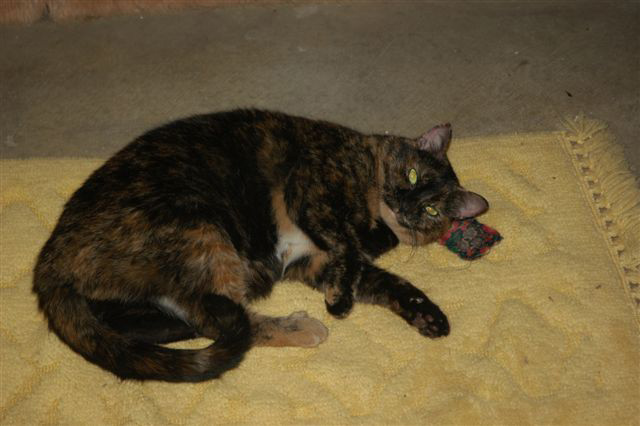
HAS is filling up again and others, as lovely as Taz, will be killed for “time and space.”
There will be, or already has been, a #78.
-------
This time of year, when adoptions are slow and HAS is flooded not only with strays and unwanted cats but also with huge numbers of kittens and pregnant cats, the organizations that rescue from there are feeling the pressure. All of these groups are working hard - rescuing as many as they possibly can. Many are already filled to capacity.
These groups need adoptions to happen at a much faster pace to free up space and make it possible to respond to the urgent pleas to rescue more.
The July 4, 2013 article focuses on one organization, the HBSPCA. By drawing public attention to their week-long $100 adoption fee reduction, it helped make that initiative successful.
A follow-up article (“More than 50 felines saved by a whisker”) reports that there had been 50 adoptions and that's certainly good news. It means that the HBSPCA has space again and can resume rescuing cats. But it does not mean, as the article may have implied, that "the cat crisis" is over.
During "kitten season," of which there is no end in sight, HAS often becomes packed beyond capacity. This week, next week and well into the fall there will be days when time is running out for cats and kittens awaiting rescue.
The municipal staff at HAS wants these felines to make it out alive. They and the HBSPCA, along with all the cat rescue groups involved, are doing what they can. It's important for the public to remember that it's adoptions that keep that rescue effort moving; the title of that first article, "Here's your chance to save some fluffy little lives," says it well.
|






 The sweet little burn victim got transferred over to the HBSPCA. A posting on that organization's Facebook today (Nov. 14) announcing that he's now goes by the name Trooper, reports that his burns are healing nicely and provides a video showing how well he's doing.
The sweet little burn victim got transferred over to the HBSPCA. A posting on that organization's Facebook today (Nov. 14) announcing that he's now goes by the name Trooper, reports that his burns are healing nicely and provides a video showing how well he's doing. The lovely tortoiseshell with that awful wound, now named Marigold, got rescued by Ladybird Animal Sanctuary and updates on their Facebook report that, despite a lot of damage to the surrounding skin and muscle, her wound is healing well. X-rays taken showed that her hip was fractured and further x-rays will determine if the hip fracture will require surgery. But she's eating and using her litter box and she's likely to pull through.
The lovely tortoiseshell with that awful wound, now named Marigold, got rescued by Ladybird Animal Sanctuary and updates on their Facebook report that, despite a lot of damage to the surrounding skin and muscle, her wound is healing well. X-rays taken showed that her hip was fractured and further x-rays will determine if the hip fracture will require surgery. But she's eating and using her litter box and she's likely to pull through. donation towards his vet bills, a volunteer driver picked him up and he was transported (in a carrying case borrowed from HAS) to one of the rescues. Finally able to relax, he's purring and hoping again - this time for his very own forever home.
donation towards his vet bills, a volunteer driver picked him up and he was transported (in a carrying case borrowed from HAS) to one of the rescues. Finally able to relax, he's purring and hoping again - this time for his very own forever home. But time may be running out. HAS is horribly overcrowded. One of those urgent messages was sent out yesterday to rescues and once again there's a "closed" sign on the door. The rescue groups, themselves full and strapped for funds, are rushing in - but can they empty enough cages and can they do it fast enough? Though HAS is turning away the non-emergency cases, they're still responding to emergency calls and they're still taking in the sick and injured ones that keep arriving at the door.
But time may be running out. HAS is horribly overcrowded. One of those urgent messages was sent out yesterday to rescues and once again there's a "closed" sign on the door. The rescue groups, themselves full and strapped for funds, are rushing in - but can they empty enough cages and can they do it fast enough? Though HAS is turning away the non-emergency cases, they're still responding to emergency calls and they're still taking in the sick and injured ones that keep arriving at the door.  quickly, alerting the HBSPCA and all the local and out-of-town rescues they work with and something amazing happened. As if by magic, 46 rescues took place. HAS was able to open up the shelter again and, as the stats for the week show, managed to end the week not having had to put down any one of those cats or kittens due to "Time/Space."
quickly, alerting the HBSPCA and all the local and out-of-town rescues they work with and something amazing happened. As if by magic, 46 rescues took place. HAS was able to open up the shelter again and, as the stats for the week show, managed to end the week not having had to put down any one of those cats or kittens due to "Time/Space."



 mother cats, having seen their litters go and having been spayed to avoid further litters, need to get adopted too and when the Rescue Groups are urgently needing help to find them homes.
mother cats, having seen their litters go and having been spayed to avoid further litters, need to get adopted too and when the Rescue Groups are urgently needing help to find them homes.

